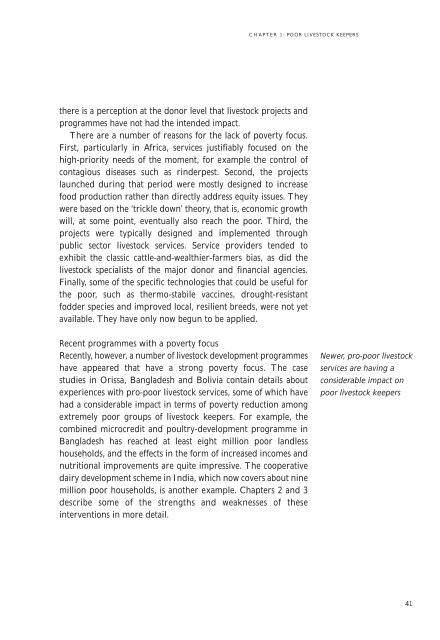Livestock Services and the Poor: A global initiative - IFAD
Livestock Services and the Poor: A global initiative - IFAD
Livestock Services and the Poor: A global initiative - IFAD
You also want an ePaper? Increase the reach of your titles
YUMPU automatically turns print PDFs into web optimized ePapers that Google loves.
CHAPTER 1: POOR LIVESTOCK KEEPERS<br />
<strong>the</strong>re is a perception at <strong>the</strong> donor level that livestock projects <strong>and</strong><br />
programmes have not had <strong>the</strong> intended impact.<br />
There are a number of reasons for <strong>the</strong> lack of poverty focus.<br />
First, particularly in Africa, services justifiably focused on <strong>the</strong><br />
high-priority needs of <strong>the</strong> moment, for example <strong>the</strong> control of<br />
contagious diseases such as rinderpest. Second, <strong>the</strong> projects<br />
launched during that period were mostly designed to increase<br />
food production ra<strong>the</strong>r than directly address equity issues. They<br />
were based on <strong>the</strong> ‘trickle down’ <strong>the</strong>ory, that is, economic growth<br />
will, at some point, eventually also reach <strong>the</strong> poor. Third, <strong>the</strong><br />
projects were typically designed <strong>and</strong> implemented through<br />
public sector livestock services. Service providers tended to<br />
exhibit <strong>the</strong> classic cattle-<strong>and</strong>-wealthier-farmers bias, as did <strong>the</strong><br />
livestock specialists of <strong>the</strong> major donor <strong>and</strong> financial agencies.<br />
Finally, some of <strong>the</strong> specific technologies that could be useful for<br />
<strong>the</strong> poor, such as <strong>the</strong>rmo-stabile vaccines, drought-resistant<br />
fodder species <strong>and</strong> improved local, resilient breeds, were not yet<br />
available. They have only now begun to be applied.<br />
Recent programmes with a poverty focus<br />
Recently, however, a number of livestock development programmes<br />
have appeared that have a strong poverty focus. The case<br />
studies in Orissa, Bangladesh <strong>and</strong> Bolivia contain details about<br />
experiences with pro-poor livestock services, some of which have<br />
had a considerable impact in terms of poverty reduction among<br />
extremely poor groups of livestock keepers. For example, <strong>the</strong><br />
combined microcredit <strong>and</strong> poultry-development programme in<br />
Bangladesh has reached at least eight million poor l<strong>and</strong>less<br />
households, <strong>and</strong> <strong>the</strong> effects in <strong>the</strong> form of increased incomes <strong>and</strong><br />
nutritional improvements are quite impressive. The cooperative<br />
dairy development scheme in India, which now covers about nine<br />
million poor households, is ano<strong>the</strong>r example. Chapters 2 <strong>and</strong> 3<br />
describe some of <strong>the</strong> strengths <strong>and</strong> weaknesses of <strong>the</strong>se<br />
interventions in more detail.<br />
Newer, pro-poor livestock<br />
services are having a<br />
considerable impact on<br />
poor livestock keepers<br />
41

















